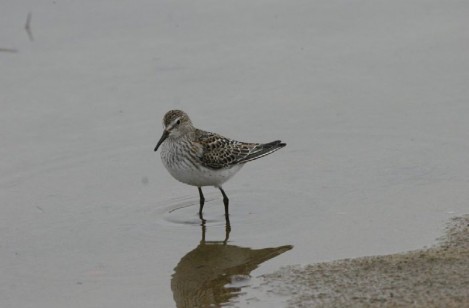Wayne R. Petersen

by Wayne Petersen
At one level this month’s mystery photograph is straightforward: the bird is a shorebird. To be precise it is a sandpiper, not a plover. Plovers have short, relatively stout bills, somewhat steep and angular foreheads, large eyes, and in some species prominently ringed or banded breasts. This bird has none of these features so we can conclude it belongs in the family Scolopacidae (sandpipers and allies) and not Charadriidae (plovers). Knowing that the species is a scolopacid eliminates the five regularly-occurring species of Massachusetts plovers.
The combination of a finely streaked breast, distinct whitish supercilium (eye stripe), dark legs, and a relatively short, straight bill eliminates approximately twenty species of sandpipers and sandpiper relatives (e.g., yellowlegs, Whimbrel, godwits, Ruddy Turnstone, Red Knot, Stilt Sandpiper, dowitchers, phalaropes) as identification possibilities. Indeed, the jizz (i.e., overall impression) of the mystery sandpiper strongly suggests that it is one of the small, similar-looking sandpipers collectively called peep (i.e., Baird’s, White-rumped, Western, Semipalmated, and Least sandpiper), or possibly the somewhat similar Sanderling, Pectoral Sandpiper, or Dunlin.
Having narrowed down the identification possibilities it is helpful to also determine the plumage or age of the bird. The absence of a rich, rusty-colored head and chest or a distinct black belly patch remove Sanderling or Dunlin in breeding (alternate) plumage as options. Additionally, the crisp and scaly appearance of the back, scapulars, and wing coverts created by the pale fringes to those feathers and the fine necklace of streaking on the upper breast all identify the mystery bird as a juvenile.
A juvenile Sanderling would never exhibit the crisp necklace of streaks shown by the bird in the photograph, a Dunlin would have a much longer and droopy-tipped bill, and a Pectoral Sandpiper would have noticeably pale (yellowish) legs and a more extensively streaked breast.
Having reduced the possibilities to Baird’s, White-rumped, Western, Semipalmated, or Least sandpiper, shape becomes a helpful feature. The mystery sandpiper is long and attenuated at the rear. This distinctive shape is created by the sandpiper’s long wings which, when folded, extend beyond the tail. The Baird’s and the White-rumped sandpiper share this feature. Not surprisingly these species are long-distance migrants that travel deep into southern South America for the winter. Although the Baird’s and the White-rumped have a somewhat similar shape, the Baird’s Sandpiper lacks the prominent supercilium of the mystery sandpiper and would have a less crisply streaked breast pattern and an even scalier overall dorsal pattern than the mystery bird. In a color photograph a Baird’s Sandpiper would also have a warmer, more buff-colored face and head than the mystery shorebird. This bird is a juvenile White-rumped Sandpiper (Calidris fuscicollis) in fresh juvenal plumage, the way many individuals appear in October when they pass through Massachusetts.
White-rumped Sandpipers are relatively uncommon late spring migrants and common to very common mid to late fall migrants in Massachusetts at favored localities along the immediate coast, especially on Cape Cod. A few individuals linger into mid-November before finally departing for their Patagonian wintering grounds. The author photographed this White-rumped Sandpiper on North Beach in Orleans on November 15, 2009.